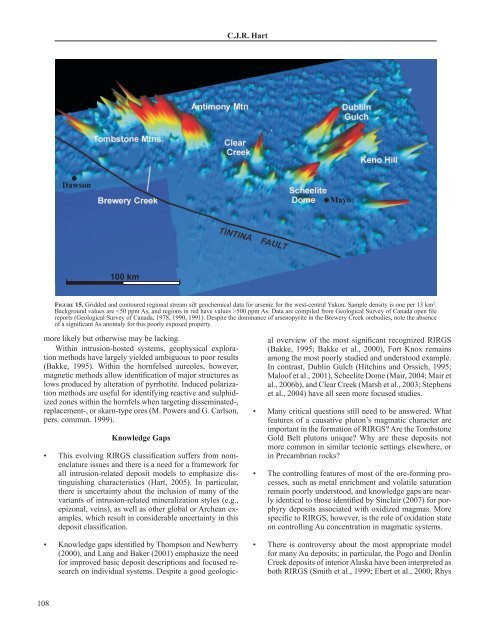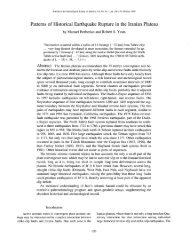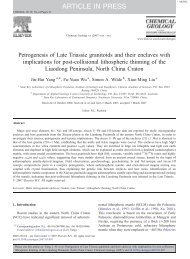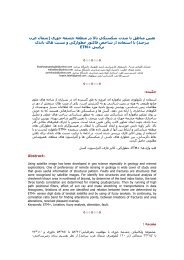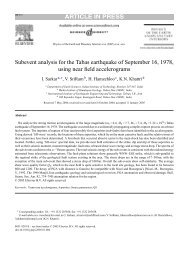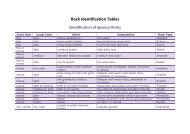Reduced Intrusion-Related Gold System - GSINET | Geological ...
Reduced Intrusion-Related Gold System - GSINET | Geological ...
Reduced Intrusion-Related Gold System - GSINET | Geological ...
Create successful ePaper yourself
Turn your PDF publications into a flip-book with our unique Google optimized e-Paper software.
C.J.R. Hart<br />
Dawson<br />
Mayo<br />
100 km<br />
FIGURE 15. Gridded and contoured regional stream silt geochemical data for arsenic for the west-central Yukon. Sample density is one per 13 km 2 .<br />
Background values are 500 ppm As. Data are compiled from <strong>Geological</strong> Survey of Canada open file<br />
reports (<strong>Geological</strong> Survey of Canada, 1978, 1990, 1991). Despite the dominance of arsenopyrite in the Brewery Creek orebodies, note the absence<br />
of a significant As anomaly for this poorly exposed property.<br />
more likely but otherwise may be lacking.<br />
Within intrusion-hosted systems, geophysical exploration<br />
methods have largely yielded ambiguous to poor results<br />
(Bakke, 1995). Within the hornfelsed aureoles, however,<br />
magnetic methods allow identification of major structures as<br />
lows produced by alteration of pyrrhotite. Induced polarization<br />
methods are useful for identifying reactive and sulphidized<br />
zones within the hornfels when targeting disseminated-,<br />
replacement-, or skarn-type ores (M. Powers and G. Carlson,<br />
pers. commun. 1999).<br />
•<br />
•<br />
Knowledge Gaps<br />
This evolving RIRGS classification suffers from nomenclature<br />
issues and there is a need for a framework for<br />
all intrusion-related deposit models to emphasize distinguishing<br />
characteristics (Hart, 2005). In particular,<br />
there is uncertainty about the inclusion of many of the<br />
variants of intrusion-related mineralization styles (e.g.,<br />
epizonal, veins), as well as other global or Archean examples,<br />
which result in considerable uncertainty in this<br />
deposit classification.<br />
Knowledge gaps identified by Thompson and Newberry<br />
(2000), and Lang and Baker (2001) emphasize the need<br />
for improved basic deposit descriptions and focused research<br />
on individual systems. Despite a good geologic-<br />
•<br />
•<br />
•<br />
al overview of the most significant recognized RIRGS<br />
(Bakke, 1995; Bakke et al., 2000), Fort Knox remains<br />
among the most poorly studied and understood example.<br />
In contrast, Dublin Gulch (Hitchins and Orssich, 1995;<br />
Maloof et al., 2001), Scheelite Dome (Mair, 2004; Mair et<br />
al., 2006b), and Clear Creek (Marsh et al., 2003; Stephens<br />
et al., 2004) have all seen more focused studies.<br />
Many critical questions still need to be answered. What<br />
features of a causative pluton’s magmatic character are<br />
important in the formation of RIRGS Are the Tombstone<br />
<strong>Gold</strong> Belt plutons unique Why are these deposits not<br />
more common in similar tectonic settings elsewhere, or<br />
in Precambrian rocks<br />
The controlling features of most of the ore-forming processes,<br />
such as metal enrichment and volatile saturation<br />
remain poorly understood, and knowledge gaps are nearly<br />
identical to those identified by Sinclair (2007) for porphyry<br />
deposits associated with oxidized magmas. More<br />
specific to RIRGS, however, is the role of oxidation state<br />
on controlling Au concentration in magmatic systems.<br />
There is controversy about the most appropriate model<br />
for many Au deposits; in particular, the Pogo and Donlin<br />
Creek deposits of interior Alaska have been interpreted as<br />
both RIRGS (Smith et al., 1999; Ebert et al., 2000; Rhys<br />
108


